PRP for Hair Restoration Vancouver
If you’re concerned about hair thinning (alopecia), you’re not alone. In fact, 40% of men will experience some form of hair loss by the time they reach 40 years of age.
Although there are many causes of hair loss, the most common genetic type is androgenetic alopecia, which occurs in men and women. While there are many advertised remedies, only a few are backed by scientific studies. PRP hair restoration is a non-surgical treatment option that uses the patient’s own blood to help stimulate hair regrowth.
If you’re considering PRP therapy, it’s important to be aware that PRP will not work for everyone. There are many factors to consider. In this article, we’ll take a closer look and try to give you useful information to help decide if this treatment may be right for you.
Why consider PRP for hair loss?
PRP, or platelet rich plasma, contains different growth factors that stimulate new hair growth and reduce hair loss. The treatment involves taking a sample of your blood, processing it using a centrifuge to create a high concentration of platelets in plasma (hence the name), and injecting it back into the scalp.
PRP works by using a small sample of the patient’s own blood to help stimulate hair growth. PRP is made by separating the blood and concentrating the platelets in a small volume of plasma to create a solution that is rich in natural growth factors. PRP is injected into the scalp where it works by improving blood supply to the hair root and stimulating the dormant hair follicles. Overall this should lead to healthier hair.
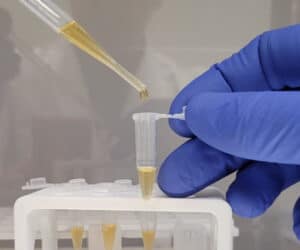
Clinical studies using platelet-rich plasma for thinning hair
PRP was not originally developed for hair, and actually has many other treatment uses, for example skin care, acne scar, arthrtis, sports injuries and more. However, in one of the earliest hair related studies in 2006, Uebel showed that with hair transplants, grafts soaked in PRP had a 15% higher survival rate than hair without PRP. 1 Since then, many other studies have been published about the benefits of PRP for hair growth showing mostly positive results.
One recent review from the Journal of Cosmetic Dermatology looked at six studies involving 177 patients. They demonstrated a significant overall increase in the growth of new hair. Hair density increased by 17.90 per cm² and there was also an increase in hair thickness.2 Another review of 12 studies showed that in all but two, PRP results in a significant benefit. In the two studies which did not show benefit, there were only 1 or 2 treatments, and in one study, the PRP was not activated prior to use.3
Does PRP for hair growth work for everyone?
There is no type of treatment for alopecia which works for everyone. There can be many reasons for hair loss, and PRP should only be used when there is a good chance of success. This is especially important because PRP can be quite an expensive and time consuming process. Even when it does work, it usually takes several months or more to see results. At PRP Medical Aesthetics, we start with a medical consultation, examination and possibly labs tests before deciding whether PRP will be offered to any patient.
Who is a good candidate for PRP for hair restoration?
Before considering PRP, a careful medical history should be taken to look for other factors which may be related. Some of these might include: iron deficiency, thyroid disorders (e.g. hypothyroidism), hormone imbalances, stress or recent illness, recent pregnancy, diabetes, etc. More advanced stages of hair loss will not respond as well. No patient should be started on PRP without considering other causes of hair loss. In addition to medical consultation, appropriate lab tests should be ordered as part of this investigation. We do not offer PRP to every patient, and may delay treatments while other underlying conditions are dealt with.
Can PRP alone regrow hair?
When done properly, most cases of PRP have resulted in some level of improvement following treatment, sometimes with notably thicker, healthier-looking hair. However, PRP is not a miracle treatment and it’s important to understand that best results are often achieved when PRP is used in combination with other medical treatments and lifestyle changes.
What are some other treatments for hair loss and thinning?
Although alopecia is very common, there are only a few approved treatments which have been shown to work. These include minoxidil (Rogaine®), and finasteride (Propecia®). Other drugs like spironolactone are sometimes used off-label. Topical preparations may include other ingreadients such as progesterone or tretinoin. It’s important to monitor for scalp irritation when using any topical product.
It is advisable to combine PRP with other medications such as minoxidil or finasteride to acheive better results overall. In addition, therapies such as low-level laser (LLLT) and microneedling have been shown to benefit hair and can be done at home. Scalp massage has also been shown to help with hair.
Overall, PRP works the best, but in combination with other treatments can work even better. It’s important to remember that most loss is chronic and progressive, meaning it gets worse over time. Until there is a cure, it’s best to continue to use multiple treatments in combination.
What’s the best type of PRP for hair loss?
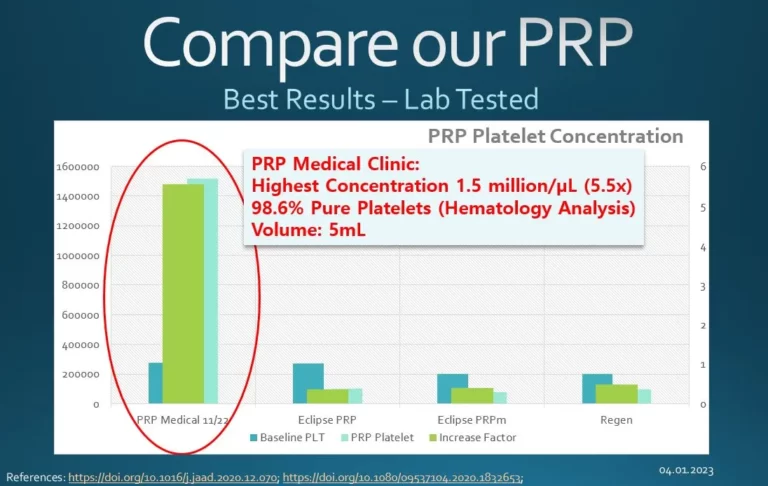
The quality of PRP is an extremely important but often overlooked factor. Platelet concentration directly affects the growth factor release, which of course, will affect the results. Higher platelet concentration will promote hair growth better. One study showed that low concentration PRP (produced with a Regen Kit) actually caused hair LOSS.4
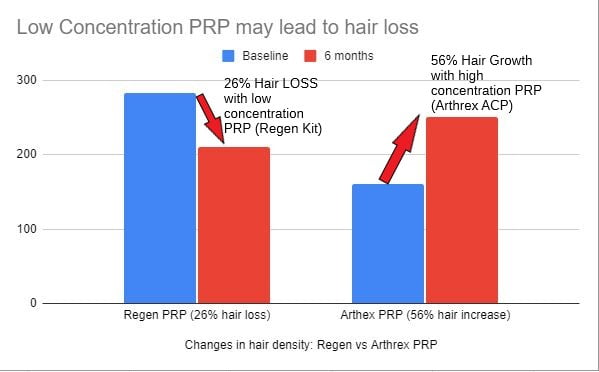
Unfortunately, there is a wide range of concentration and quality of PRP being used, with many different manufacturers of PRP systems. A recent review by Magalon et al identified 50 different manufacturers of PRP systems worldwide. 5Unfortunately, they also found that most of the PRP systems being used today simply do not give a high enough platelet concentration to even meet the definition of true PRP (1 million per microliter, as defined by Marx).6
Even having a good PRP system does not guarantee a high concentration each time, as there is often a large variation between sessions even with the same patient and same PRP system. This is why at PRP Medical Aesthetics, we test your PRP just before we use it and will not proceed if the concentration is not high enough.
Always ask about the type of PRP being used for your sessions and whether it’s tested before use. We offer PRP testing and analysis at our clinic. See this page for more information about the best type of PRP system
How many PRP sessions are needed?
Based on multiple research studies, we usually recommend 3 to 6 PRP treatment sessions spaced every 2-6 weeks apart in order to achieve optimal results.
The number and frequency of PRP sessions seems to be important. While most studies looked at monthly treatments for 3-4 sessions. Waiting longer than one month between sessions is not as beneficial. A study published by the American Society for Dermatologic Surgery recently looked at 40 patients where half received a total of 4 treatments – once a month for 3 months, followed by a booster 3 months later; while the other 20 patients received only two total treatments, with 3 months separation between sessions.7
Measurements at 6 months showed that while both groups had improvement, the group which had two extra treatments had over 400% better response compared with the first group, in terms of hair count per cm² (29.6 vs 7.2; p < 0.001).7
During your consultation, Dr. Yam will be able to provide you with a better estimate of the number and frequency of sessions based on your individual circumstances. It’s also important to remember that in most cases, PRP is not a permanent solution and maintenance treatments should be done once or twice a year.
How much does PRP hair loss treatment cost in Vancouver?
The cost of PRP treatment in Vancouver BC can range from $700 to $1200 per session depending on the clinic you visit. PRP Medical Aesthetics offers PRP hair restoration for a competitive price (starting at $700 and up, depending on the concentration and type of PRP), which includes laboratory testing and analysis of your PRP concentration, quality and dose (total number of platelets). Our clinic is conveniently located in the greater Vancouver area, in Richmond BC.
We also offer Acell (accellular micromatrix) and PRF (platelet-rich fibrin) treatments. ACell is combined with PRP while PRF is given on its own.
Before you visit any clinic in Vancouver, remember that the most important factor in deciding on and effective treatment for hair restoration might not be price, but the concentration and quality of the PRP being prepared. It is also vital to have a proper medical consultation including any appropriate lab tests.
Is PRP painful?
The answer to this question is, it depends. The scalp is a very sensitive area. We’ve found that the most reliable way to reduce pain is a lidocaine block. Although this adds time to the procedure, we feel it’s worth it as most patients report zero pain after the block is done. We have tried other methods of numbing like strong numbing cream, ice, vibration, nitrous gas and they simply don’t work as well. A comfortable patient is a happy patient!
What to expect during a PRP treatment for hair loss?
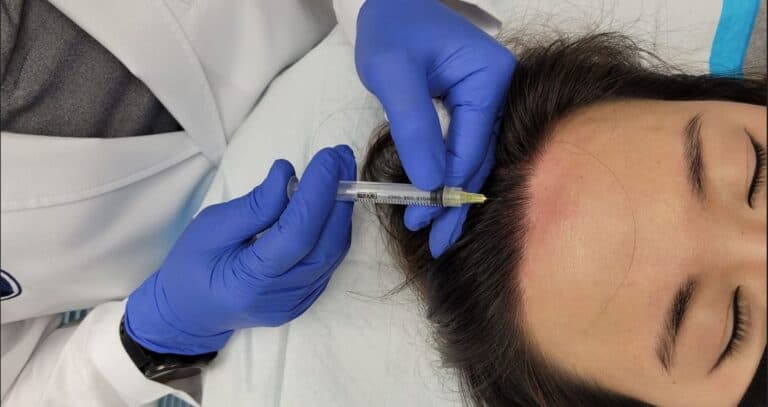
There are several steps to having a PRP Hair Treatment at PRP Medical Aesthetics Clinic:
1. Blood draw. We take about 50 mL of blood. This is more than double the small amount of blood that most clinics take. Our research has shown that this is the best way to stimulate dormant hair follicles.
2. We test your baseline platelet counts using our hematology analyzer. If you have low platelets, we may recommend drawing more blood.
3. We carefully proces your blood to obtain PRP. This process usually takes about an hour as we have to go through several steps, including a double-spin PRP process to obtain the highest possible concentration.
3. We use a medical hematology analyzer to test the platelet concentration of the plasma during the creation of PRP .
4. We test your PRP sample for concentration, composition (purity), and calculate the final dose of platelets. Please note, if your PRP is not concentrated enough, we will not perform the treatment as you will likely not see results. This hardly ever happens, but if it does, we can usually still get the procedure done, just not on the same day. We may need to do lab tests to determine if there is an underlying health problem, or sometimes start with more blood.
5. Dr. Yam will numb your scalp using a lidocaine nerve block. Although this takes longer, we have found this to be the most effective way to reduce pain from PRP. Lidocaine nerve blocks work far better than numbing cream, ice, vibration or other methods. Lidocaine will not interfere with the PRP because we do not inject lidocaine in the areas where we are putting the PRP.
6. With your scalp fully numb, Dr. Yam will inject PRP into the thinning areas using a manual technique for best control and placement of the PRP injections. This usually involves about 80-160 injections, but most of our patients feel no pain at all, thanks to the lidocaine nerve block.
What to expect after a PRP hair restoration treatment?
Expect your scalp to remain numb for a few hours after your treatment. You may have mild tenderness which can usually be managed with plain tylenol if needed. It’s preferable to wait about 24 hours before washing your hair. Other than this, the short recovery process is usually very easy. The PRP will continue to release growth factors to stimulate hair for a few days after the treatment. As mentioned, most people won’t notice much change in their hair for several months. More on this below:
When will I see hair regrowth?
It takes time to notice results from PRP therapy for hair loss. This is because hair grows slowly through the natural hair cycles (anagen, telogen, catagen). While some patients may notice hair growth within a few months, it often takes up to 6 months after a series of treatments for hair follicles to grow and results to become visible.
You may see a noticeable improvement in the amount and thickness of hair. Hair darkening can also occur with PRP, which is thought to be due to an overall increase in the hair shaft thickness.
How to know if PRP hair injections are working?
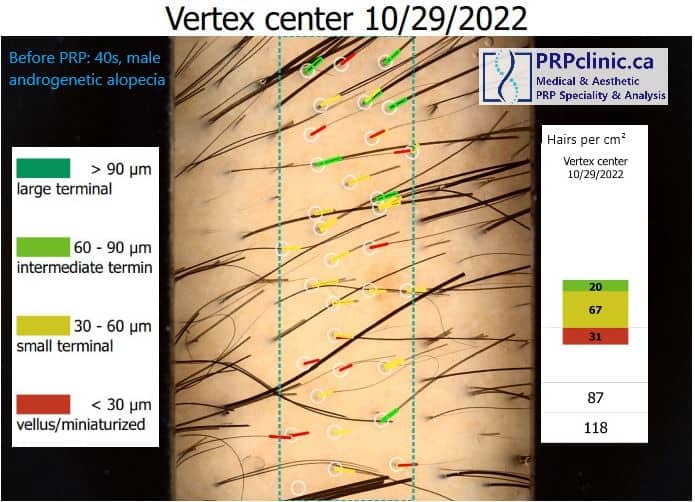
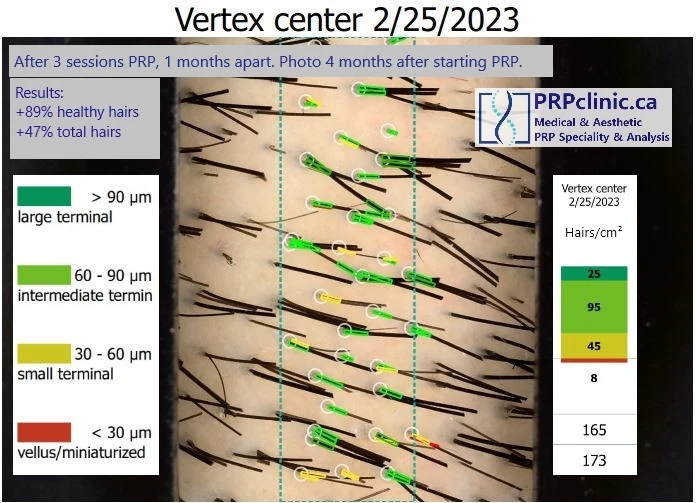
Since PRP does not work for everyone, it is important to have a unbiased system to follow the results as objectively as possible. At PRP Medical Aesthetics, we use the Hair Metrix Camera analysis system by Canfield Scientific. The photos above are close ups taken with the HairMetrix system. It consists of a specialized hair camera and software which counts and measures the hair using high magnification to give a report of the density, thickness and overall health of your hair. The Hair Metrix analysis is very useful and should be done before starting treatment and once or twice a year after that to monitor the health of your hair.
Can PRP regrow hair in bald areas?
Unfortunately, the answer is no. PRP is designed to help revive dormant and weakened hair follicles that still exist in the scalp, not to create new ones. So if you’ve got a shiny bald spot where there are no existing follicles, the treatment won’t do much for it.
That being said, it’s important to note that PRP can still help slow down the rate of thinning and improve hair volume if used in combination with other treatments such as minoxidil.
What about other types of hair loss?
Although less research is available, PRP has been reported to work well for types of alopecia, including telogen effluvium, alopecia areata, and even some types of scarring alopecia, although this is beyond the scope of this article.8 At PRP Medical Aesthetics, we’ve treated cases of telogen effluvium, alopecia areata, and types of cicatricial (scarring) alopecia.
Is PRP better than a hair transplant?
When the loss is mild to moderate, PRP has been shown to improve hair thickness and density, but in more advanced cases, where the effects of hair loss are too severe to be managed by PRP alone, it may be wise to consult with a hair surgeon. The good thing is that PRP contains growth factors that can help
How long does PRP last?
When done correctly, and with proper supporting treatments, (see above), improvements from PRP can last for up to 18-24 months. As for visible results, clinical studies have shown that it can take up to 6-12 months before the full effects of the treatment can be seen. However, the length of time between treatments can vary depending on factors such as age, type of alopecia and overall health. These and other important considerations should be part of the consultation process when deciding whether PRP is right for you.
Are PRP treatments safe?
When performed by an experienced medical provider PRP is considered very safe. The side effects are minimal (see above), and the pain is usually almost zero if proper numbing procedures are used (ie. lidocaine nerve block).
The risk of infection and inflammation is very low due to your own blood being used as the primary medium for this procedure. In fact, PRP itself has anti-infective properties. To ensure safety during the process, it’s best to consult with an experienced provider who will take all necessary precautions for safe and optimal results.
Risks and Side Effects of PRP Hair Treatment
While PRP hair treatment is generally considered a safe and effective procedure, there are some potential side effects to keep in mind. These may include mild pain, tenderness, swelling, headache, itching and bleeding at the injection site. These reactions are typically mild and decrease within a day or two and can be managed with over-the-counter medications such as Tylenol.
It’s important to note that although probably safe, PRP hair treatment is not recommended for those who are pregnant or breastfeeding. Furthermore, individuals with certain medical conditions such as hepatitis or HIV should also consult their doctor prior to this type of treatment.
In addition, it’s advised that you avoid alcohol consumption or smoking at least 5 days before and after PRP sessions due to its harmful effects on platelets.
Finally, there is the risk that PRP will not work for you. Using PRP for hair restoration is still considered “experimental”. Even though multiple research studies have suggested that it’s helpful, it is not a panacea.
Conclusion: Are you concerned about thinning hair?
- PRP is a newer, advanced treatment that may help you regain your hair, but it may not be right for everyone.
- For the best chance at improvement, PRP should be done by an expert.
- Testing of PRP is the only way to check the quality of every treatment.
- PRP has been shown to rejuvenate many types of tissue. Studies have shown that PRP can help improve hair loss and hair thickness.
- While PRP is not a cure for baldness, it may be able to increase hair density and thickness.
If you are interested in having a consultation to see if PRP could be a part of your treatment plan, please contact us today at PRP Medical Aesthetics (PRP Laser and Skin Care Centre).
Finally, if you made it this far, we hope it was helpful and thank you for reading!
Academic References
- 1.Uebel C, da S, Cantarelli D, Martins P. The role of platelet plasma growth factors in male pattern baldness surgery. Plast Reconstr Surg. 2006;118(6):1458-1466. doi:10.1097/01.prs.0000239560.29172.33
- 2.Giordano S, Romeo M, Lankinen P. Platelet-rich plasma for androgenetic alopecia: Does it work? Evidence from meta analysis. J Cosmet Dermatol. Published online March 13, 2017:374-381. doi:10.1111/jocd.12331
- 3.Cervantes J, Perper M, Wong LL, et al. Effectiveness of Platelet-Rich Plasma for Androgenetic Alopecia: A Review of the Literature. Skin Appendage Disord. Published online June 24, 2017:1-11. doi:10.1159/000477671
- 4.Gentile P, Cole J, Cole M, et al. Evaluation of Not-Activated and Activated PRP in Hair Loss Treatment: Role of Growth Factor and Cytokine Concentrations Obtained by Different Collection Systems. Int J Mol Sci. 2017;18(2). doi:10.3390/ijms18020408
- 5.Magalon J, Brandin T, Francois P, et al. Technical and biological review of authorized medical devices for platelets-rich plasma preparation in the field of regenerative medicine. Platelets. 2021;32(2):200-208. doi:10.1080/09537104.2020.1832653
- 6.Marx RE. Platelet-Rich Plasma (PRP): What Is PRP and What Is Not PRP? Implant Dentistry. Published online December 2001:225-228. doi:10.1097/00008505-200110000-00002
- 7.Hausauer AK, Jones DH. Evaluating the Efficacy of Different Platelet-Rich Plasma Regimens for Management of Androgenetic Alopecia: A Single-Center, Blinded, Randomized Clinical Trial. DS. Published online September 2018:1191-1200. doi:10.1097/dss.0000000000001567
- 8.Gupta AK, Versteeg SG, Rapaport J, Hausauer AK, Shear NH, Piguet V. The Efficacy of Platelet-Rich Plasma in the Field of Hair Restoration and Facial Aesthetics—A Systematic Review and Meta-analysis. J Cutan Med Surg. Published online January 4, 2019:185-203. doi:10.1177/1203475418818073
